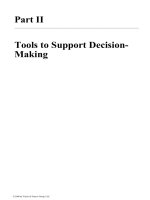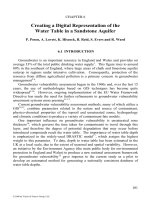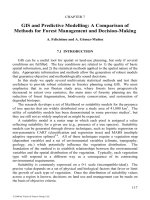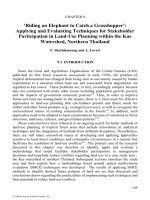Fuzzy modeling for multicriteria decision making under uncertainty
Bạn đang xem bản rút gọn của tài liệu. Xem và tải ngay bản đầy đủ của tài liệu tại đây (1.7 MB, 115 trang )
FUZZY MODELING FOR MULTICRITERIA DECISION
MAKING UNDER UNCERTAINTY
WANG WEI
NATIONAL UNIVERSITY OF SINGAPORE
2003
FUZZY MODELING FOR MULTICRITERIA DECISION MAKING
UNDER UNCERTAINTY
WANG WEI
(B.Eng., XI’AN UNIVERSITY OF TECHNOLOGY)
A THESIS SUBMITTED
FOR THE DEGREE OF MASTER OF ENGINEERING
DEPARTMENT OF INDUSTRIAL AND SYSTEMS ENGINEERING
NATIONAL UNIVERSITY OF SINGAPORE
2003
ACKNOWLEDGMENTS
I would like to thank:
Prof. Poh Kim-Leng, my supervisor, for his guidance, encouragement and support in the
course of my research.
The National University of Singapore for offering me a research scholarship and the
Department of Industrial and Systems Engineering for providing research facilities.
My friends, for their help.
My parents, for their care and love.
i
TABLE OF CONTENTS
Acknowledgments………………………………………………….……………………...i
Table of Contents………………………………………………………………………....ii
Summary…………………………………………………………………………….........iv
Nomenclature…..…………………..…………………………………………………......vi
List of Figures………………………………………………………………………........vii
List of Tables……………………………………………………………………….…...viii
1 Introduction…………………………………………………………………………....1
2
1.1
Background…………………………………………………………….…….........1
1.2
Motivations…………………………………………………………………….......4
1.3
Methodology.….......................................................................................................5
1.4
Contributions………………………………………………………….…………...6
1.5
Organization of the Thesis ………………………………………….…………….7
Literature Survey…………………………………………………………………..…9
2.1
Classical MCDM Methods………………………………………………………...9
2.1.1 The Weighted Sum Method……….………………………………………...10
2.1.2 The Weighted Product Method………………….…………………………..11
2.1.3 The AHP Method……………......………....………………………………..12
2.1.4 The ELECTRE Method………….…………………………………………..13
2.1.5 The TOPSIS Method………………………….……………………………..18
2.2
Fuzzy Set Theory and Operations………………………………………………..21
2.2.1 Basic Concepts and Definitions……………………………………………..22
2.2.2 Ranking of Fuzzy Numbers………………………………………………….26
2.3
Fuzzy MCDM Methods………………………………………………………….27
2.3.1 The Fuzzy Weighted Sum Method………………………………………….28
2.3.2 The Fuzzy Weighted Product Method…………….………………………...29
2.3.3 The Fuzzy AHP Method………………….…………………………………29
ii
2.3.4 The Fuzzy TOPSIS Method……………………………….………………...30
2.4
3
Summary…………………………………………………………………………32
Fuzzy Extension of ELECTRE……………………………………………………..33
3.1
Introduction………………………………………………………………………33
3.2
The Proposed Method……………………………………………………………35
3.2.1 Fuzzy Outranking Measurement…………………………………………….35
3.2.2 Proposed Fuzzy ELECTRE………………………………………………….37
4
5
A Numerical Example of Fuzzy ELECTRE……………………………………….43
4.1
A Step-by-step Approach………………………………………………………...43
4.2
Summary………………………………………………………………….……...48
Fuzzy MCDM Based on Risk and Confidence Analysis………………………….50
5.1
Introduction………………………………………………………………………50
5.2
Modeling of Linguistic Approach………………………………………………..51
5.3
The Proposed Method ………………………………………………………...…53
5.3.1 Modeling of Risk Attitudes………………………………………………….54
5.3.2 Modeling of Confidence Attitudes…………………………………………..57
5.3.3 Proposed Fuzzy MCDM based on Risk and Confidence Analysis………….63
6 A Numerical Example of
Fuzzy MCDM Based on Risk and Confidence Analysis………………………..…73
6.1
A Step-by-step Approach……………………………………………………...…73
6.2
Summary…………………………………………………………………………91
7 Conclusion and Future Work………………………………………………………93
7.1
Conclusion………………………………………………………………………..93
7.2
Future Work……………………………………………………………….……..95
References………………………………………………………………………………..97
iii
SUMMARY
Multiple criteria decision making (MCDM) refers to the problem of selecting or ranking a
finite set of alternatives with usually noncommensurate and conflicting criteria. MCDM
methods have been developed and applied in many areas. Obviously, uncertainty always
exists in the human world. Fuzzy set theory is a perfect means for modeling imprecision,
vagueness, and subjectiveness of information. With the application of fuzzy set theory, the
fuzzy MCDM methods are effective and flexible to deal with complex and ill-defined
problems.
Two fuzzy MCDM methods are developed in this thesis. The first one is fuzzy extension
of ELECTRE. In this method, fuzzy ranking measurement and fuzzy preference
measurement are proposed to construct fuzzy outranking relations between alternatives.
With reference to the decision maker (DM)’s preference attitude, we establish the
concordance sets and discordance sets. Then the concordance index and discordance index
are used to express the strengths and weaknesses of alternatives. Finally, the performance
index is obtained by the net concordance index and net discordance index. The sensitivity
analysis of the threshold of the DM’s preference attitude can allow comprehension of the
problem and provide a flexible solution.
Another method we proposed is fuzzy MCDM based on the risk and confidence analysis.
Towards uncertain information, the DM may show different risk attitudes. The optimist
tends to solve the problem in a favorable way, while the pessimist tends to solve the
iv
problem in an unfavorable way. In assessing uncertainty, the DM may have different
confidence attitudes. More confidence means that he prefers the values with higher
possibility. In this method, risk attitude and confidence attitude are incorporated into the
decision process for expressing the DM’s subjective judgment and assessment. Linguistic
terms of risk attitude towards interval numbers are defined by triangular fuzzy numbers.
Based on the α-cut concept, refined triangular fuzzy numbers are defined to express
confidence towards uncertainty. By two imagined ideal solutions of alternatives: the
positive ideal solution and the negative ideal solution, we measure the alternatives’
performances under confidence levels. These values are aggregated by confidence vectors
into the overall performance. This method is effective in treating the DM’s subjectiveness
and imprecision in the decision process. The sensitivity analysis on both risk and
confidence attitudes provides deep insights of the problem.
v
NOMENCLATURE
R
Set of real numbers
R+
Set of positive real number
~
A
Fuzzy set and fuzzy number
µ A~ ( x)
~
Membership function of x in A
~
Supp ( A)
~
Support set of A
~
Aα
~
α -cut of A
al (α )
Lower value of interval of confidence at level α
au (α )
Upper value of interval of confidence at level α
( a1 , a2 , a3 ) A triangular fuzzy number
T (x)
Set of linguistic term
∀x
Universal quantifier (for all x )
∃x
Existential quantifier (there exists an x )
<
Strict total order relation
≤
Non-strict total order relation
∪
Union
∩
Intersection
∅
Empty subset
vi
LIST OF FIGURES
~
Figure 2.1 A fuzzy number A ………………………………………………………........23
~
Figure 2.2 A fuzzy number A with α-cuts….....................................................................24
~
Figure 2.3 A triangular fuzzy number A = (a1 , a 2 , a3 ) …………………………………..24
Figure 4.1 Sensitivity analysis with the DM’s preference attitudes………………………48
Figure 5.1 Linguistic terms of risk attitude……………………………………………….56
Figure 5.2 A triangular fuzzy number A~ and its α-cut triangular fuzzy number…………58
Figure 5.3 Linguistic terms of confidence attitude……….………………………………60
Figure 6.1 Performance value under AO with respect to confidence levels……………...76
Figure 6.2 Performance value under VO with respect to confidence levels……………...78
Figure 6.3 Performance value under O with respect to confidence levels………………..79
Figure 6.4 Performance value under FO with respect to confidence levels……………...80
Figure 6.5 Performance value under N with respect to confidence levels………………..81
Figure 6.6 Performance value under FP with respect to confidence levels………………82
Figure 6.7 Performance value under P with respect to confidence levels………………..83
Figure 6.8 Performance value under VP with respect to confidence levels……………....84
Figure 6.9 Performance value under AP with respect to confidence levels………………85
Figure 6.10 Performance index of A1 under risk and confidence attitudes………………86
Figure 6.11 Performance index of A2 under risk and confidence attitudes………………87
Figure 6.12 Performance index of A3 under risk and confidence attitudes………………88
Figure 6.13 Performance index of A4 under risk and confidence attitudes………………89
vii
LIST OF TABLES
Table 4.1 Decision matrix and weighting vector...………………………………….……43
Table 4.2 Normalized decision matrix……………………………………………………44
Table 4.3 Weighted normalized decision matrix…………………………………………44
Table 4.4 Preference measurements with respect to C1…………………………………..45
Table 4.5 Preference measurements with respect to C2…………………………….…….45
Table 4.6 Preference measurements with respect to C3…………………………………..45
Table 4.7 Preference measurements with respect to C4…………………………..………45
Table 4.8 Outranking relations with respect to C1 when λ =0.2…………………………45
Table 4.9 Outranking relations with respect to C2 when λ =0.2…………………………46
Table 4.10 Outranking relations with respect to C3 when λ =0.2………………………..46
Table 4.11 Outranking relations with respect to C4 when λ =0.2………………………..46
Table 4.12 Concordance indices when λ =0.2……………………………….…………...46
Table 4.13 Discordance indices when λ =0.2……………………………………….……46
Table 4.14 Net concordance indices (NCI) and net discordance indices (NDI)
When λ =0.2……….….......…………………………………………..………47
Table 4.15 Performance indices (PI) when λ =0.2…………………………….…………47
Table 4.16 Performance indices with respect to λ values…………………….…………47
Table 5.1: Linguistic terms of decision attitude…………………………………………..56
Table 5.2 Linguistic terms of confidence attitude………………………………………...59
Table 6.1 Decision matrix and weighting vector…………………………………...….....73
Table 6.2 Performance matrix ……………...…………………………………………….74
viii
Table 6.3 Performance matrix under AO attitude………………………………………...74
Table 6.4 Performance matrix under AO attitude when α=0.5…………………………...74
Table 6.5 Normalized performance matrix under AO attitude when α=0.5……………...75
Table 6.6 Separation distance under AO when α=0.5……………………………………75
Table 6.7 Performance index under AO with 11 confidence levels………………………76
Table 6.8 Confidence vector under 11 confidence levels………………………………...77
Table 6.9 Performance index under AO with respect to confidence attitudes…………..77
Table 6.10 Performance index under VO with 11 confidence levels……………………..78
Table 6.11 Performance index under VO with respect to confidence attitudes………..…78
Table 6.12 Performance index under O with 11 confidence levels………………………79
Table 6.13 Performance index under O with respect to confidence attitudes…………….79
Table 6.14 Performance index under FO with 11 confidence levels……………………..80
Table 6.15 Performance index under FO with respect to confidence attitudes…………..80
Table 6.16 Performance index under N with 11 confidence levels……………………….81
Table 6.17 Performance index under N with respect to confidence attitudes…………….81
Table 6.18 Performance index under FP with 11 confidence levels……………………..82
Table 6.19 Performance index under FP with respect to confidence attitudes…...………82
Table 6.20 Performance index under P with 11 confidence levels ………………………83
Table 6.21 Performance index under P with respect to confidence attitudes…….………83
Table 6.22 Performance index under VP with 11 confidence levels…………….…….....84
Table 6.23 Performance index under VP with respect to confidence attitudes…………...84
Table 6.24 Performance index under AP with 11 confidence levels……………………..85
Table 6.25 Performance index under AP with respect to confidence attitudes…………...85
ix
Table 6.26 Performance index of A1 under risk and confidence attitudes……………….86
Table 6.27 Performance index of A2 under risk and confidence attitudes……………….87
Table 6.28 Performance index of A3 under risk and confidence attitudes……………….88
Table 6.29 Performance index of A4 under risk and confidence attitudes……………….89
Table 6.30 Ranking order of A1 under risk and confidence attitudes……………………90
Table 6.31 Ranking order of A2 under risk and confidence attitudes……………………90
Table 6.32 Ranking order of A3 under risk and confidence attitudes……………………91
Table 6.33 Ranking order of A4 under risk and confidence attitudes……………………91
x
Chapter 1: Introduction
Chapter 1
Introduction
1.1 Background
Making decisions is a part of our lives. Most decision problems are made based on
multiple criteria. For example, in a personal context, one chooses a job based on its salary,
location, promotion opportunity, reputation and so on. In a business context, a car
manufacturer needs to design a model which maximizes fuel efficiency, maximizes riding
comfort, and minimizes production cost and so on. In these problems, a decision maker
needs to have relevant criteria or objectives. These criteria or objectives usually conflict
with one another and the measurement units of these criteria or objectives are usually
incommensurable. Solutions of these problems are either to design the best alternative or
to select or rank the predefined alternatives.
Multicriteria decision making (MCDM) is one of the most well known branches of
decision making and has been one of the fast growing problem areas during the last two
decades. From a practical viewpoint, two main theoretical streams can be distinguished.
First, by assuming continuous solution spaces, multiple objective decision making
(MODM) models solve problems given a set of objectives and a set of well defined
constraints. MODM problems are usually called multiple objective optimization problems.
The second stream focuses on problems with discrete decision spaces. That is to solve
1
Chapter 1: Introduction
problems by ranking, selecting or prioritizing given a finite number of courses of action
(alternatives). This stream is often called multiple attribute decision making. Methods and
applications of these two streams in the case of a single decision maker have been
thoroughly reviewed and classified (Hwang and Yoon, 1981; Hwang and Masud, 1979).
In this thesis, our research scope focuses on the second stream. The more general term
MCDM is used here.
The basic characteristics of MCDM are alternatives and criteria. They are explained as
follows.
Alternatives
A finite number of alternatives need to be screened, prioritized, selected and ranked. The
alternatives may be referred to as “candidates” or “actions”, among others.
Multiple Criteria
Each MCDM problem is associated with multiple criteria. Criteria represent the different
dimensions from which the alternatives can be viewed.
In the case where the number of criteria is large, the criteria may be arranged in a
hierarchical structure for a clear representation of problems. Each major criterion may be
associated with several sub-criteria and each sub-criterion may be associated with several
sub-sub-criteria and so on. Although some MCDM problems may have a hierarchical
structure, most of them assume a single level of criteria. A desirable list of criteria should:
(1) be complete and exhaustive. All important performance criteria relevant to the final
2
Chapter 1: Introduction
decision should be represented; (2) be mutually exclusive. This permits listed criteria as
independent entities among which appropriate trade-offs may later be made. And this
helps prevent undesirable “double-counting” in the worth sense; (3) be restricted to
performance criteria of the highest degree of importance. The purpose is to provide a
sound basis from which lower level criteria may subsequently be derived.
Conflict among Criteria
Criteria usually conflict with one another since different criteria represent different
dimensions of the alternatives. For instance, cost may conflict with profit etc.
Incommensurable Units
Criteria usually have different units of measurement. For instance, in buying a car, the
criteria “cost” and “mileage” may be measured in terms of dollars and thousands of miles,
respectively. Normalization methods can be used for commensuration among criteria.
Some methods that are often used include vector normalization and linear scale
transformation.
Decision Weights
Most MCDM problems require that the criteria be assigned weights to express their
corresponding importance. Normally, these weights add up to one. Besides the weights
being assigned by a decision maker directly, other main methods include: (1) eigenvector
method (Saaty, 1977), (2) weighted least square method (Chu et al, 1979), (3) entropy
method (Shannon, 1947), and (4) LINMAP (Srinivasan and Shocker, 1973) (Hwang, C.L.
and Yoon, K., 1981).
3
Chapter 1: Introduction
Decision Matrix
MCDM problems can be concisely expressed in a matrix format. Suppose that there are m
alternatives and n criteria in a decision-making problem. A decision matrix D is a m × n
matrix. It is also assumed that the decision maker has determined the weights of relative
importance of the decision criteria. This information is expressed as follows:
x11
x
D = 21
K
x m1
x12
x 22
K
xm 2
x1n
K x 2 n
,
K K
K x mn
K
W = ( w1 , K , w j , K , wn ) ,
where xij is the rating of alternative Ai with respect to criterion C j , represented by a
matrix referred to as the decision matrix. w j is the weight of criterion C j , represented by
a vector referred to as the weighting vector.
1.2 Motivations
In the real world, an exact description of real situations may be virtually impossible. In
MCDM problems, uncertainties mainly come from four sources: (1) unquantifiable
information, (2) incomplete information, (3) nonobtainable information, (4) partial
ignorance. Classical MCDM methods do not handle problems with such imprecise
information. The application of fuzzy set theory to MCDM problems provides an effective
way of dealing with the subjectiveness and vagueness of the decision processes for the
general MCDM problem. Research on fuzzy MCDM methods and its applications have
been explored in many monographs and papers (Bellman and Zadeh, 1970; Carlsson
4
Chapter 1: Introduction
1982; Zimmermann, 1987; Dubois and Prade, 1994; Herrera and Verdegay, 1997; Chen
and Hwang, 1992). In these fuzzy MCDM approaches, the majority of the methods require
cumbersome computations. This leads to difficulties in solving problems with many
alternatives and criteria. The complex computation in the ranking of fuzzy numbers often
leads to unreliable, even counter-intuitive results. Human subjective attitude towards
uncertainty is seldom studied to provide human-oriented solutions in the fuzzy decision
problems.
1.3 Methodology
Zadeh (1965) proposed fuzzy set theory as the means for representing, quantifying, and
measuring the inherent uncertainty in the real world. Fuzziness is a type of imprecision
which may be associated with sets in which there are no sharp transition from membership
to nonmembership. It presents a mathematical way to deal with vagueness, impreciseness
and subjectiveness in complex and ill-defined decision problems.
Triangular Fuzzy Number
For many practical applications and fuzzy mathematics problems, triangular fuzzy
numbers are simple in operating and approximating. In the triangular fuzzy
~
number A = ( a1 , a2 , a3 ) , a1 , a 2 and a3 represents lower, modal and upper value of
presumption to uncertainty. In the inverse, multiplication, and division operations, the
outcome does not necessarily give a real triangular fuzzy number. But using an
approximation of triangular fuzzy numbers is enough to reflect the facts without much
5
Chapter 1: Introduction
divergence. When the DM considers the uncertain ratings of the alternatives and the
weights of the criteria, the triangular fuzzy number approach is usually used. Linguistic
terms also can be simply expressed by triangular fuzzy numbers.
Linguistic Variable
The linguistic approach is intended to be used in situations in which the problem is too
complex or too ill-defined to be amenable to quantitative characterization. It deals with the
pervasive fuzziness and imprecision of human judgment, perception and modes of
reasoning. A linguistic variable can be regarded either as a variable whose value is a fuzzy
number or as a variable whose values are defined in linguistic terms.
1.4 Contributions
The objective of this research is to develop fuzzy MCDM methods. This thesis proposes
two novel approaches.
The first proposed method is a fuzzy extension of ELECTRE. In this method, we first
propose a fuzzy ranking measurement to construct the relations between two alternatives.
Preference measurement is then used to represent pairwise preferences between two
alternatives with reference to the whole set of alternatives. Based on the DM’s preference
attitudes, we establish the concordance and discordance sets. The corresponding
concordance and discordance indices are used to express the strengths of outranking
relations. The net concordance and discordance indices are combined to obtain the
6
Chapter 1: Introduction
performance of alternatives. In this procedure, the preference attitude is incorporated in
the outranking process to provide a more flexible way to evaluate and analyze alternatives.
The second method that we (Wang and Poh, 2003a, 2003b, 2003c, 2003d, and 2003e)
proposed is a fuzzy MCDM method based on risk and confidence analysis. In this
method, the risk attitude and confidence attitude are defined by linguistic terms. The
triangular fuzzy numbers are proposed to incorporate the DM’s risk attitudes towards an
interval of uncertainty. In order to deal with the DM’s confidence in the fuzzy
assessments, based on the α-cut concept, we proposed refined triangular fuzzy numbers to
assess the confidence level towards uncertainty. Confidence vectors are obtained from the
membership functions of confidence attitudes. By using confidence vectors, the
alternatives’ performances on confidence levels are aggregated as the final performance to
evaluate the alternatives. This method incorporates the DM’s subjective judgment and
assessments towards uncertainty into the decision process. Thus, by considering human
adaptability and dynamics of preference, the proposed method is effective in solving
complex and ill-defined MCDM problems.
1.5 Origination of The Thesis
The next chapter presents a state-of-the-art survey of crisp MCDM methods, an overview
of the fuzzy set theory and operations, as well as the fuzzy MCDM methods. Then in
chapters three and four we present the proposed fuzzy extension of ELECTRE method and
an example, respectively. In chapters five and six we introduce the proposed fuzzy
7
Chapter 1: Introduction
MCDM method based on risk attitude and confidence attitude and an example,
respectively. Finally, chapter seven concludes our work in this thesis.
8
Chapter 2: Literature Survey
Chapter 2
Literature Survey
In this Chapter, we first present an overview of crisp MCDM methods. Then we give an
introduction of fuzzy set theory and operations. Finally, by the application of fuzzy set
theory, we introduce the fuzzy MCDM methods.
2.1 Crisp MCDM Methods
An MCDM method is a procedure to process alternatives’ values in order to arrive at a
choice. There are three basic steps in MCDM methods to evaluate the alternatives. First of
all, we formulate the problem by determining the relevant criteria and alternatives.
Secondly, we attach numerical measures to the relative importance of the criteria as the
weights and to the impacts of the alternatives on criteria as the ratings. Finally, we process
the numerical values of the ratings of alternatives and weights of criteria to evaluate
alternatives and determine a ranking order.
There are two major approaches in information processing: noncompensatory and
compensatory models. Each category includes the relevant MCDM methods.
Noncompensatory models do not permit tradeoffs among criteria. An unfavorable value in
one criterion cannot be offset by a favorable value in some criteria. The comparisons are
made on a criterion-by-criterion basis. The models in this category are dominance,
9
Chapter 2: Literature Survey
maximin, maximax, conjunctive constraint method, disjunctive constraint method, and
lexicographic method. Compensatory models make tradeoffs among criteria. These
models include the weighted sum model (WSM), the weighted product model (WPM), the
analytic hierarchy process (AHP), TOPSIS, ELECTRE, LINMAP, nonmetric MDS,
permutation method, linear assignment method.
The weighted sum model (WSM) is the earliest and widely used method. The weighted
product model (WPM) can be considered as a modification of the WSM, and has been
proposed for overcoming some of the weaknesses in WSM. The AHP proposed by Saaty
(1980) is a later development and has recently become increasingly popular. A revised
AHP suggested by Belton and Gear (1983) appears to be more consistent than the original
approach. Other widely used methods are the TOPSIS and ELECTRE. Next, we give an
overview of some of the popular methods, namely WSM, WPM, AHP, TOPSIS, and
ELECTRE.
2.1.1 The Weighted Sum Method
The WSM is probably the best known and highly used method of decision making.
Suppose there are m alternatives and n criteria in a decision-making problem. An
alternative’s performance is defined as (Fishburn, 1967):
n
pi = ∑ xij w j , i = 1,2,..., m ,
(2.1)
j =1
where xij is the rating of the i th alternative in terms of the j th decision criterion, and w j
is the weight of the j th criterion. The best alternative is the one which has the maximum
10
Chapter 2: Literature Survey
value (in the maximization case). The WSM method can be applied without difficulty in
single-dimensional cases where all units of measurement are identical. Because of the
additive utility assumption, a conceptual violation occurs when the WSM is used to solve
multidimensional problems in which the units are different.
2.1.2 The Weighted Product Method
The WPM uses multiplication to rank alternatives. Each alternative is compared with
others by multiplying a number of ratios, one for each criterion. Each ratio is raised to the
power of the relative weight of the corresponding criterion. Generally, in order to compare
two alternatives Ak and Al , the following formula (Miller and Starr, 1969) is used:
A
Q k
Al
n x
= ∏ kj
j =1 xlj
wj
,
(2.2)
where xij is the rating of the i th alternative in terms of the j th decision criterion, and w j
is the weight of the j th criterion. If the above ratio is greater than or equal to one, then (in
the maximization case) the conclusion is that alternative Ak is better than alternative Al .
Obviously, the best alternative is the one which is better than or at least as good as all
other alternatives. The WPM is sometimes called dimensionless analysis because its
structure eliminates any units of measurement. Thus, the WPM can be used in single- and
multidimensional decision problems.
11
Chapter 2: Literature Survey
2.1.3 The AHP Method
The Analytic Hierarchy Process (AHP) approach deals with the construction of a matrix
(where there are m alternatives and n criteria). In this matrix the element aij represents the
relative performance of the i th alternative in terms of the j th criterion. The vector
Ai = (ai1 , ai 2 ,..., ain ) for the i th alternative ( i = 1,2,..., m) is the eigenvector of an n × n
reciprocal matrix which is determined through a sequence of pairwise comparisons (Saaty,
1980). In the original AHP,
∑
n
j =1
wij = 1 .
According to the AHP, an alternative’s performance is defined as:
n
pi = ∑ aij w j , i = 1,2,..., m .
(2.3)
j =1
The AHP uses relative values instead of actual ones. Therefore, the AHP can be used in
single- and multidimensional decision problems.
The RAHP (Belton and Gear, 1983) is a revised version of the original AHP model. The
shortcoming of the AHP is that it is sometimes possible to yield unjustifiable ranking
reversals. The reason for the ranking inconsistency is that the relative performance
measures of all alternatives in terms of each criterion are summed to one. Instead of
having the relative values sum to one, they propose that each relative value be divided by
the maximum value in the corresponding vector of relative values. That is known as the
ideal-model of AHP.
12
Chapter 2: Literature Survey
2.1.4 The ELECTRE Method
The ELECTRE (Elimination and Choice Translating Reality; English translation from the
French original) method was originally introduced by Benayoun et al. (1966). It focuses
on the concept of outranking relation by using pairwise comparisons among alternatives
under each criterion separately. The outranking relationship of the two alternatives Ak and
Al , denoted as Ak → Al , describes that even though Ak does not dominate Al
quantitatively, the DM accepts the risk of regarding Ak as almost surely better than Al
(Roy, 1973).
The ELECTRE method begins with pairwise comparisons of alternatives under each
criterion. It elicits the so-called concordance index, named as the amount of evidence to
support the conclusion that Ak outranks or dominates Al , as well as the discordance
index, the counterpart of the concordance index. This method yields binary outranking
relations between the alternatives. It gives a clear view of alternatives by eliminating less
favorable ones and is convenient in solving problems with a large number of alternatives
and a few criteria. There are many variants of the ELECTRE method. The original version
of the ELECTRE method is illustrated in the following steps.
Suppose there are m alternatives and n criteria. The decision matrix element xij is the
rating of the i th alternative in terms of the j th criterion, and w j is the weight of the j th
criterion.
13









